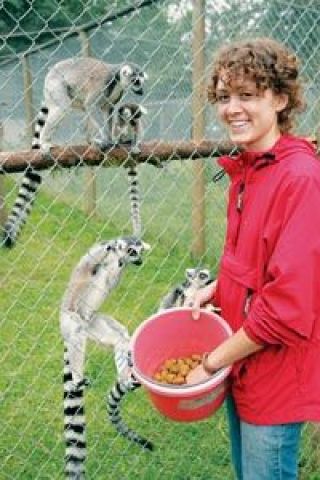Mville resident works in conservation after graduation
LANGLEY, BC Five sets of beady orange eyes intensely follow Katherine Ramos as she unlocks a gate to an enclosure, her red food bucket in hand. As she approaches, four adult ring-tailed lemurs jump and grunt excitedly, a baby holds tightly to its mothers back.
Ramos, an Animal Keeper Intern at Langley, B.C.s Mountainview Breeding and Conservation Society, recently graduated from Trinity Western University with a bachelor in science, majoring in biology. She was first exposed to Mountainview after attending a field trip to the society while at university. After graduation, the 22-year-old took initiative, looking for work experience after her degree and landed herself an internship at the society.
The two-month internship has had Ramos working primarily with the lemurs at Mountainview, including two Red Ruffed Lemurs named Ringo and Romulus who are the oldest lemurs in captivity Each day she takes to the feeding and cleaning of the lemur environments. As she hands out slices of banana to her fury troops Ramos said, Each one has its own personality. At first I didnt know how to tell the difference between them. My manager challenged me to be able to identify each one in case they ever got hurt or sick. Now Ramos not only knows them by name but makes special attention to see that everyone gets their fair share of the food and even helped her co-worker name the newest addition to the lemur group, a baby named Ranger.
As Ramos drags some maple branches and berry bushes into the enclosure, little lemur hands break off pieces and begin to eat, their eyes bright and alert. She explained, One of the things were doing is enrichment. Typical enrichment activities include things that stimulate the lemurs to learn to forage for food themselves. They really like maple leaves and the raspberries so this activity would be typical of what they would do in the wild.
Renee Bumpus, Carnivore Area Manager at Mountainview said, To find work in this business you really need to get out there and get practical work experience. Katherine began first volunteering while at university which then led to this internship because we had built a relationship with her. She brings a real commitment to our projects and a drive and dedication to really learn animal behaviors which is key. Katherine has been a dream employee.
Ramos, a Marysville Washington resident, has loved animals ever since she was a child. She first heard about Trinity Western University through a friend and was attracted to the institution because of its private and faith based academics.
While working with animals is the perfect fit vocationally for Ramos, she didnt always believe it would happen. She said, When I was trying to figure out what I was going to take in university I tossed around a variety of practical ideas, and then I reconnected with my passion, knowing that God could give me the ability to work with animals. To complete her degree, Ramos studied everything from biochemistry to physics, but thoroughly enjoyed studying the zoology portion, learning about the social structure and anatomy of species.
With her internship ending at the end of June, Ramos is beginning to plan her next steps. Im hoping to find a job as a zookeeper to get some more experience as I really want to work with primates. But my dream job would be to work with endangered species and be part of a greater conservation initiative. Mountainview would be good because it brings awareness to conservation and to breeding programs that have reintroduction programs, said Ramos.
As Ramos finishes feeding the lemurs, in the pen beside her, a very large male condor uses a section of decaying spinal chord to rap the cage, hoping to get her attention. Ramos of course, complies and gently speaks to Archie as the lemurs look on.
Mountainview has over 50 species of rare and critically endangered animals. It was founded in 1986 and focuses on a variety of breeding programs that aim to re-introduce wildlife species back into their natural habitats.
The lady and the lemurs
Mville resident works in conservation after graduation



